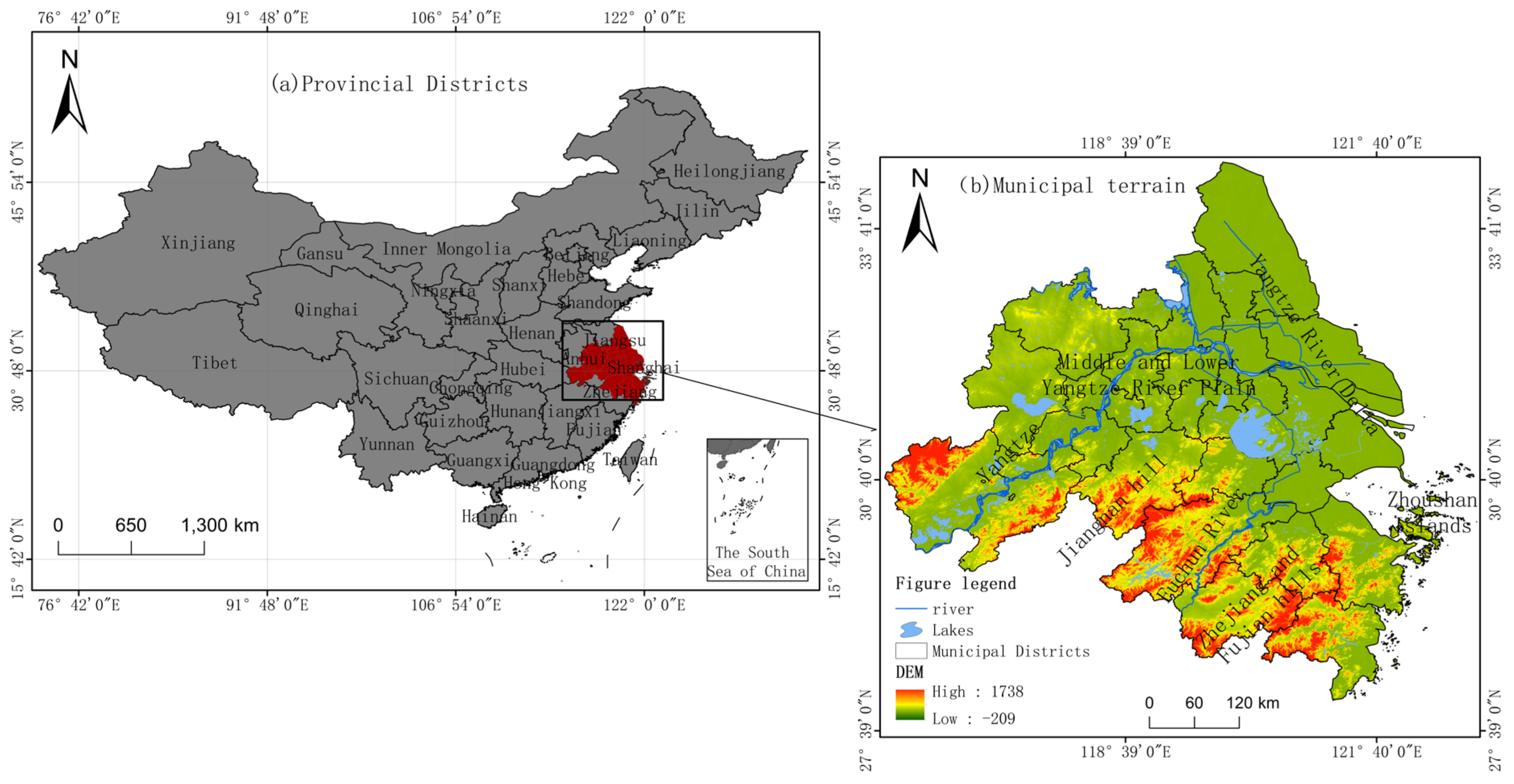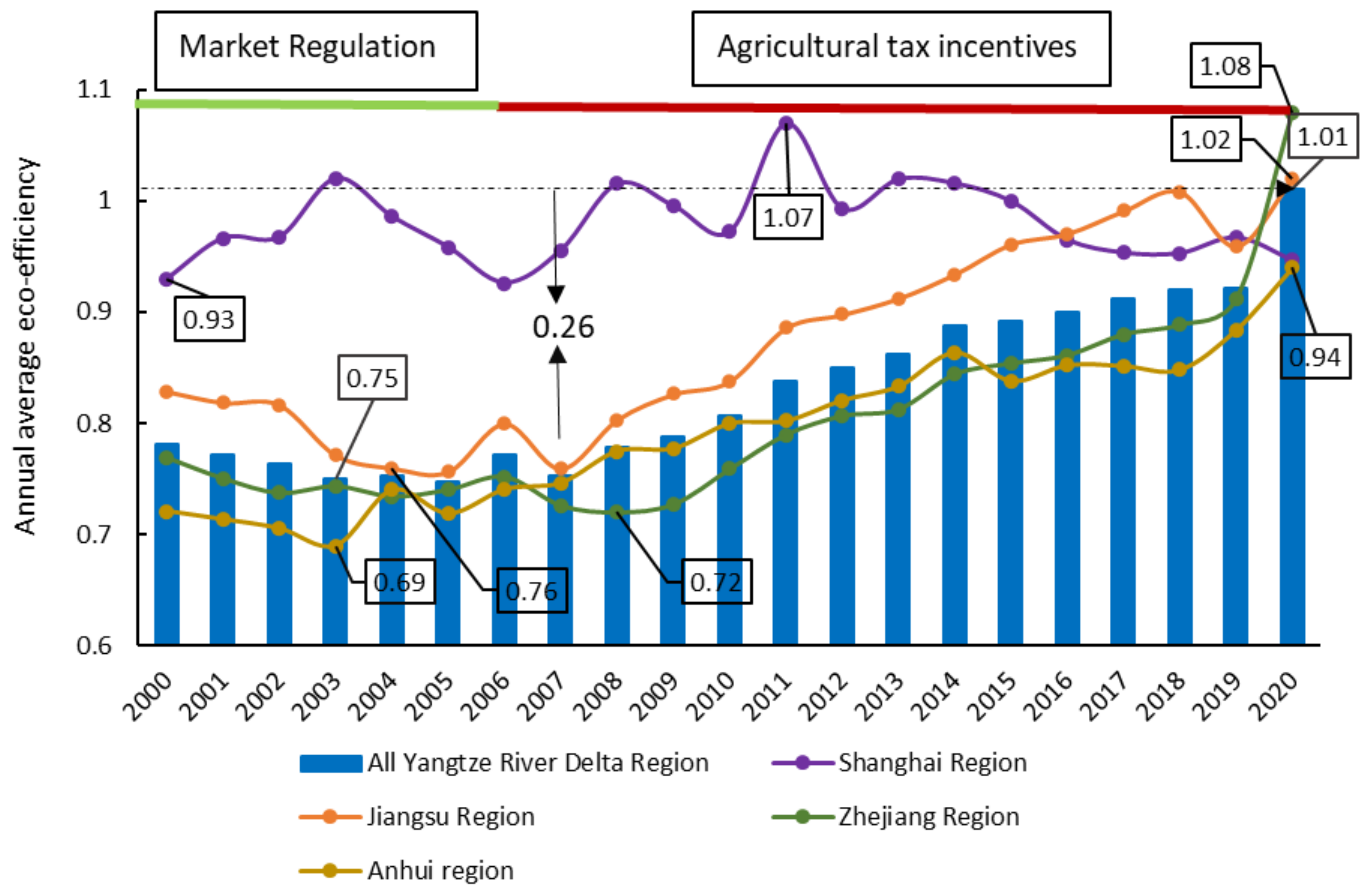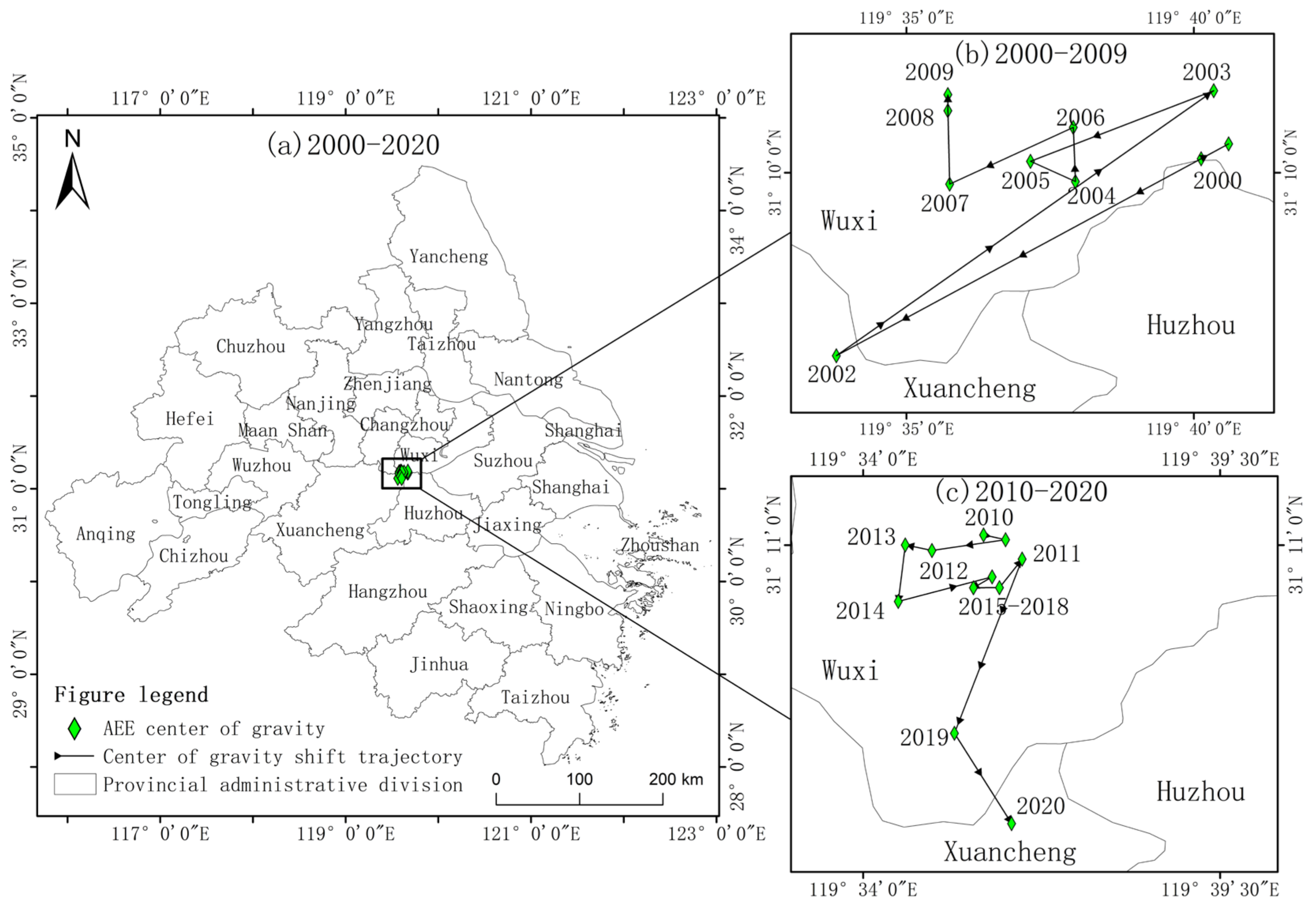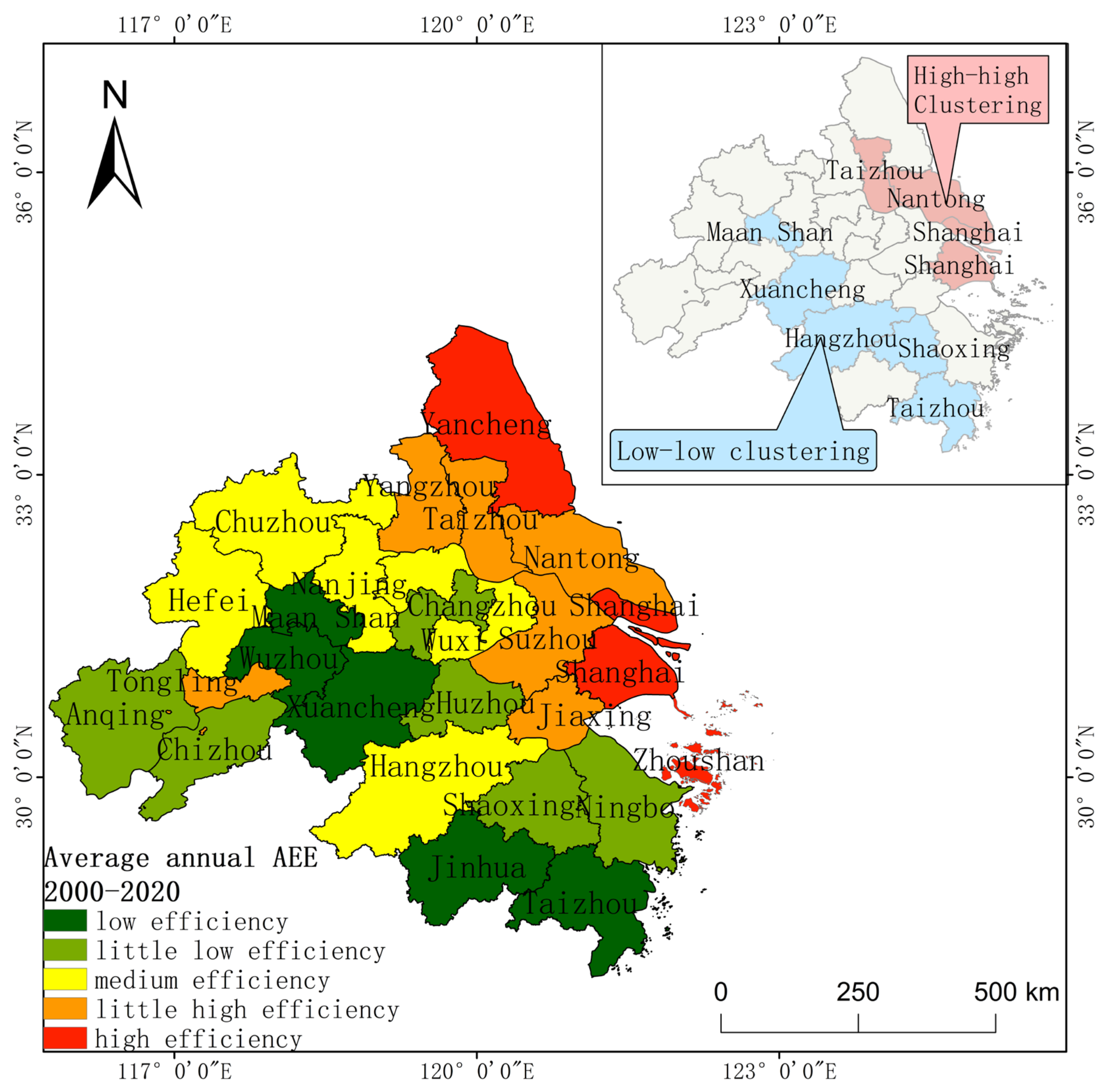Spatio-Temporal Difference in Agricultural Eco-Efficiency and Its Influencing Factors Based on the SBM-Tobit Models in the Yangtze River Delta, China
Abstract
:1. Introduction
- The innovative AEE indicator system is a new combination of agricultural factor inputs and agricultural outputs, introducing agroecological system service indicators into desired outputs to compensate for the neglected part of the gross value of agricultural production and reinforcing the accuracy of AEE values in the region.
- The areas of incompatible agricultural production and environmental protection in the region are identified, and construction advice is proposed. Specifically, the spatial and temporal characteristics, as well as driving mechanisms of agricultural eco-efficiency in the region, are assessed. The areas of slow efficiency development are identified, and relevant targeted suggestions for problem areas are provided.
- The effect of the “double carbon” policy is effectively verified. The migration of agricultural eco-efficiency pathways under the “double carbon” policy reflects the impact of related policies.
2. Literature Review
3. Materials and Methods
3.1. Study Area
3.2. AEE Indicator System
3.2.1. Indicator Design and Measurement
3.2.2. Agricultural Carbon Emission Estimation Methods
3.2.3. Methods for Estimating the Value of Farmland Ecosystem Services
3.3. Spatial Autocorrelation Analysis
3.4. Identification of Influencing Factors Based on Regression Analysis
3.4.1. Variable Description
3.4.2. Tobit Model
3.4.3. Geographically Weighted Regression Model
4. Results
4.1. Temporal and Spatial Variation Characteristics of AEE
4.2. Spatial Correlation Characteristics of Agroecological Efficiency
4.3. Analysis of Factors Influencing AEE
5. Discussion
5.1. Analysis of the Evolution of the Trend of the Center of Gravity of AEE for Low-Carbon Development
5.2. AEE Optimization Analysis
5.3. Limitations and Prosperity
6. Conclusions
- (1)
- The AEE of the YRD region is at a high level in China, averaging around 0.83 throughout the year. In terms of the temporal trend, the YRD region as a whole presents a U-shaped movement. It decreased slightly from 2000 to 2003 and increased exponentially after 2003. The efficiency value increased by 0.05 compared with the overall in 2000, with the largest increase from 2007 to 2020. Regarding spatial evolution, the high-level area of AEE in the YRD region spread from the northeastern Jiangsu and Shanghai regions to the southwestern Anhui and Zhejiang regions in a stepwise manner, with significant grade differences and significant polarization in the degree of increase: high in the southwest and low in the northeast. The overall high-efficiency area was the radiating cities centered on Yancheng and Shanghai, while the low-efficiency area was the surrounding cities centered on Wuzhou and Jinhua.
- (2)
- AEE in the YRD region generally had significant spatial correlation and dependence while exhibiting spatial and temporal heterogeneity. The 21-year average efficiency values suggested that the regional space has strong autocorrelation, among which Taizhou, Nantong, and Shanghai were clusters with high agricultural efficiency values, and Maanshan, Xuancheng, Hangzhou, Shaoxing, and Taizhou were clusters with low AEE values. With respect to time series, AEE in the YRD region displayed a “clustering–random” trend, and inter-regional correlations were weakened.
- (3)
- Except for the insignificant effect of Eir, the effects of socio-economic, agricultural production structure, and agricultural production factors were all significant at the 0.01 level in the YRD. The impact of the influencing factors on agricultural ecological efficiency is in the following order: Url, Ais, Ccs, Scl, Ami, Ecv, Pca, and Afi. Among them, urbanization level, agro-industrial structure, and crop structure were the main positive influencing factors of AEE in the YRD, and fertilizer use intensity was the main negative influencing factor.
- (4)
- The center of gravity of AEE in the YRD region under the influence of agricultural green and low-carbon policies slightly shifted to the southwest. The center of gravity shifted mainly to the northwest from 2000 to 2009. Furthermore, the center of gravity shifted mainly to the south from 2010 to 2020, and was stable in the border area of the three provinces.
Author Contributions
Funding
Institutional Review Board Statement
Informed Consent Statement
Data Availability Statement
Conflicts of Interest
References
- Peña, C.R.; Serrano, A.L.M.; de Britto, P.A.P.; Franco, V.R.; Guarnieri, P.; Thomé, K.M. Environmental preservation costs and eco-efficiency in Amazonian agriculture: Application of hyperbolic distance functions. J. Clean. Prod. 2018, 197, 699–707. [Google Scholar] [CrossRef]
- Yang, B.; Wang, Z.; Zou, L.; Zou, L.; Zhang, H. Exploring the eco-efficiency of cultivated land utilization and its influencing factors in China’s Yangtze River Economic Belt, 2001–2018. J. Environ. Manag. 2021, 294, 112939. [Google Scholar] [CrossRef] [PubMed]
- Angulo-Meza, L.; González-Araya, M.; Iriarte, A.; Rebolledo-Leiva, R.; de Mello, J.C.S. A multiobjective DEA model to assess the eco-efficiency of agricultural practices within the CF+ DEA method. Comput. Electron. Agric. 2019, 161, 151–161. [Google Scholar] [CrossRef]
- Caiado, R.G.G.; de Freitas Dias, R.; Mattos, L.V.; Quelhas, O.L.G.; Leal Filho, W. Towards sustainable development through the perspective of eco-efficiency—A systematic literature review. J. Clean. Prod. 2017, 165, 890–904. [Google Scholar] [CrossRef] [Green Version]
- Maia, R.; Silva, C.; Costa, E. Eco-efficiency assessment in the agricultural sector: The Monte Novo irrigation perimeter, Portugal. J. Clean. Prod. 2016, 138, 217–228. [Google Scholar] [CrossRef] [Green Version]
- De Corato, U. Agricultural waste recycling in horticultural intensive farming systems by on-farm composting and compost-based tea application improves soil quality and plant health: A review under the perspective of a circular economy. Sci. Total Environ. 2020, 738, 139840. [Google Scholar] [CrossRef]
- Rana, R.L.; Bux, C.; Lombardi, M. Carbon footprint of the globe artichoke supply chain in Southern Italy: From agricultural production to industrial processing. J. Clean. Prod. 2023, 391, 136240. [Google Scholar] [CrossRef]
- Coluccia, B.; Valente, D.; Fusco, G.; De Leo, F.; Porrini, D. Assessing agricultural eco-efficiency in Italian Regions. Ecol. Indic. 2020, 116, 106483. [Google Scholar] [CrossRef]
- Han, H.; Ding, T.; Nie, L.; Hao, Z. Agricultural eco-efficiency loss under technology heterogeneity given regional differences in China. J. Clean. Prod. 2020, 250, 119511. [Google Scholar] [CrossRef]
- Yang, B.; Zhang, Z.; Wu, H. Detection and attribution of changes in agricultural eco-efficiency within rapid urbanized areas: A case study in the Urban agglomeration in the middle Reaches of Yangtze River, China. Ecol. Indic. 2022, 144, 109533. [Google Scholar] [CrossRef]
- Liao, J.; Yu, C.; Feng, Z.; Zhao, H.; Wu, K.; Ma, X. Spatial differentiation characteristics and driving factors of agricultural eco-efficiency in Chinese provinces from the perspective of ecosystem services. J. Clean. Prod. 2021, 288, 125466. [Google Scholar] [CrossRef]
- Cui, X.; Wang, Y.; Zhang, G. Low–carbon Oriented Measurement and Spatiotemporal Evolution of Agricultural Eco–efficiency in China: Based on SBM–ESDA Model. Issues Agric. Econ. 2022, 9, 47–61. [Google Scholar]
- Liu, D.; Zhu, X.; Wang, Y. China’s agricultural green total factor productivity based on carbon emission: An analysis of evolution trend and influencing factors. J. Clean. Prod. 2021, 278, 123692. [Google Scholar] [CrossRef]
- Liang, J.; Long, S. China’s agricultural green total factor productivity growth and its affecting factors. Hua Nan Nong Ye Da Xue Xue Bao 2015, 14, 1–12. [Google Scholar]
- Deng, X.; Gibson, J. Improving eco-efficiency for the sustainable agricultural production: A case study in Shandong, China. Technol. Forecast. Soc. Chang. 2019, 144, 394–400. [Google Scholar] [CrossRef]
- Hou, M.; Yao, S. Convergence and differentiation characteristics on agro-ecological efficiency in China from a spatial perspective. China Popul. Resour. Environ. 2019, 29, 116–126. [Google Scholar]
- Guo, Y.; Tong, L.; Mei, L. Spatiotemporal characteristics and influencing factors of agricultural eco-efficiency in Jilin agricultural production zone from a low carbon perspective. Environ. Sci. Pollut. Res. 2022, 29, 29854–29869. [Google Scholar] [CrossRef]
- Liu, Y.; Zou, L.; Wang, Y. Spatial-temporal characteristics and influencing factors of agricultural eco-efficiency in China in recent 40 years. Land Use Policy 2020, 97, 104794. [Google Scholar] [CrossRef]
- Ait Sidhoum, A.; Canessa, C.; Sauer, J. Effects of agri-environment schemes on farm-level eco-efficiency measures: Empirical evidence from EU countries. J. Agric. Econ. 2022. [Google Scholar] [CrossRef]
- Yang, H.; Wang, X.; Bin, P. Agriculture carbon-emission reduction and changing factors behind agricultural eco-efficiency growth in China. J. Clean. Prod. 2022, 334, 130193. [Google Scholar] [CrossRef]
- Bonfiglio, A.; Arzeni, A.; Bodini, A. Assessing eco-efficiency of arable farms in rural areas. Agric. Syst. 2017, 151, 114–125. [Google Scholar] [CrossRef]
- Stępień, S.; Czyżewski, B.; Sapa, A.; Borychowski, M.; Poczta, W.; Poczta-Wajda, A. Eco-efficiency of small-scale farming in Poland and its institutional drivers. J. Clean. Prod. 2021, 279, 123721. [Google Scholar] [CrossRef]
- Wang, G.; Mi, L.; Hu, J.; Qian, Z. Spatial Analysis of Agricultural Eco-Efficiency and High-Quality Development in China. Front. Environ. Sci. 2022, 10, 193. [Google Scholar] [CrossRef]
- Yin, K.; Wang, R.; Zhou, C.; Liang, J. Review of the accounting method and its applications of the domestic and international eco-efficiency. Acta Ecol. Sin. 2012, 32, 3595–3605. [Google Scholar] [CrossRef]
- Pan, D.; Ying, R. Agricultural eco-efficiency evaluation in China based on SBM model. Sheng Tai Xue Bao 2013, 33, 3837–3845. [Google Scholar]
- Godoy-Durán, Á.; Galdeano-Gómez, E.; Pérez-Mesa, J.C.; Piedra-Muñoz, L. Assessing eco-efficiency and the determinants of horticultural family-farming in southeast Spain. J. Environ. Manag. 2017, 204, 594–604. [Google Scholar] [CrossRef]
- Coelli, T.; Rahman, S.; Thirtle, C. A stochastic frontier approach to total factor productivity measurement in Bangladesh crop agriculture, 1961–1992. J. Int. Dev. J. Dev. Stud. Assoc. 2003, 15, 321–333. [Google Scholar]
- Headey, D.; Alauddin, M.; Rao, D.P. Explaining agricultural productivity growth: An international perspective. Agric. Econ. 2010, 41, 1–14. [Google Scholar] [CrossRef]
- Grassauer, F.; Herndl, M.; Nemecek, T.; Guggenberger, T.; Fritz, C.; Steinwidder, A.; Zollitsch, W. Eco-efficiency of farms considering multiple functions of agriculture: Concept and results from Austrian farms. J. Clean. Prod. 2021, 297, 126662. [Google Scholar] [CrossRef]
- Lahouel, B.B. Eco-efficiency analysis of French firms: A data envelopment analysis approach. Environ. Econ. Policy Stud. 2016, 18, 395–416. [Google Scholar] [CrossRef]
- Tone, K. A slacks-based measure of efficiency in data envelopment analysis. Eur. J. Oper. Res. 2001, 130, 498–509. [Google Scholar] [CrossRef] [Green Version]
- Tran, T.H.; Mao, Y.; Nathanail, P.; Siebers, P.-O.; Robinson, D. Integrating slacks-based measure of efficiency and super-efficiency in data envelopment analysis. Omega 2019, 85, 156–165. [Google Scholar] [CrossRef] [Green Version]
- Khatri-Chhetri, A.; Junior, C.C.; Wollenberg, E. Greenhouse gas mitigation co-benefits across the global agricultural development programs. Glob. Environ. Change 2022, 76, 102586. [Google Scholar] [CrossRef]
- Tian, S.; Xu, Y.; Wang, Q.; Zhang, Y.; Yuan, X.; Ma, Q.; Chen, L.; Ma, H.; Liu, J.; Liu, C. Research on peak prediction of urban differentiated carbon emissions—A case study of Shandong Province, China. J. Clean. Prod. 2022, 374, 134050. [Google Scholar] [CrossRef]
- Koondhar, M.A.; Aziz, N.; Tan, Z.; Yang, S.; Abbasi, K.R.; Kong, R. Green growth of cereal food production under the constraints of agricultural carbon emissions: A new insights from ARDL and VECM models. Sustain. Energy Technol. Assess. 2021, 47, 101452. [Google Scholar] [CrossRef]
- Geoghegan, C.; O’Donoghue, C. An analysis of the social and private return to land use change from agriculture to renewable energy production in Ireland. J. Clean. Prod. 2023, 385, 135698. [Google Scholar] [CrossRef]
- Duque-Acevedo, M.; Belmonte-Ureña, L.J.; Terán-Yépez, E.; Camacho-Ferre, F. Sustainability and circularity in fruit and vegetable production. Perceptions and practices of reduction and valorization of agricultural waste biomass in south-eastern Spain. J. Environ. Manag. 2022, 316, 115270. [Google Scholar] [CrossRef]
- Arabska, E. From farm to fork: Human health and well-being through sustainable agri-food systems. J. Life Econ. 2021, 8, 11–27. [Google Scholar] [CrossRef]
- Shah, S.M.; Liu, G.; Yang, Q.; Casazza, M.; Agostinho, F.; Giannetti, B.F. Sustainability assessment of agriculture production systems in Pakistan: A provincial-scale energy-based evaluation. Ecol. Model. 2021, 455, 109654. [Google Scholar] [CrossRef]
- Tanguay, G.A.; Rajaonson, J.; Lefebvre, J.-F.; Lanoie, P. Measuring the sustainability of cities: An analysis of the use of local indicators. Ecol. Indic. 2010, 10, 407–418. [Google Scholar] [CrossRef]
- Tian, Y.; Zhang, J.-B.; He, Y.-Y. Research on spatial-temporal characteristics and driving factor of agricultural carbon emissions in China. J. Integr. Agric. 2014, 13, 1393–1403. [Google Scholar] [CrossRef] [Green Version]
- Quintas-Soriano, C.; Martín-López, B.; Santos-Martín, F.; Loureiro, M.; Montes, C.; Benayas, J.; García-Llorente, M. Ecosystem services values in Spain: A meta-analysis. Environ. Sci. Policy 2016, 55, 186–195. [Google Scholar] [CrossRef]
- Shen, Z.; Baležentis, T.; Chen, X.; Valdmanis, V. Green growth and structural change in Chinese agricultural sector during 1997–2014. China Econ. Rev. 2018, 51, 83–96. [Google Scholar] [CrossRef]
- Zhou, C.; Shi, C.; Wang, S.; Zhang, G. Estimation of eco-efficiency and its influencing factors in Guangdong province based on Super-SBM and panel regression models. Ecol. Indic. 2018, 86, 67–80. [Google Scholar] [CrossRef]
- Amon, B.; Çinar, G.; Anderl, M.; Dragoni, F.; Kleinberger-Pierer, M.; Hörtenhuber, S. Inventory reporting of livestock emissions: The impact of the IPCC 1996 and 2006 Guidelines. Environ. Res. Lett. 2021, 16, 075001. [Google Scholar] [CrossRef]
- Tian, H.; Xu, R.; Canadell, J.G.; Thompson, R.L.; Winiwarter, W.; Suntharalingam, P.; Davidson, E.A.; Ciais, P.; Jackson, R.B.; Janssens-Maenhout, G. A comprehensive quantification of global nitrous oxide sources and sinks. Nature 2020, 586, 248–256. [Google Scholar] [CrossRef]
- Wolf, J.; Asrar, G.R.; West, T.O. Revised methane emissions factors and spatially distributed annual carbon fluxes for global livestock. Carbon Balance Manag. 2017, 12, 16. [Google Scholar] [CrossRef] [Green Version]
- Janzen, H.H.; van Groenigen, K.J.; Powlson, D.S.; Schwinghamer, T.; van Groenigen, J.W. Photosynthetic limits on carbon sequestration in croplands. Geoderma 2022, 416, 115810. [Google Scholar] [CrossRef]
- Duan, H.; Zhang, Y.; Zhao, J.; Bian, X. Carbon Footprint Analysis of Farmland Ecosystem in China. J. Soil Water Conserv. 2011, 25, 203–208. [Google Scholar]
- Zhang, L.; Tian, H.; Shi, H.; Pan, S.; Chang, J.; Dangal, S.R.; Qin, X.; Wang, S.; Tubiello, F.N.; Canadell, J.G. A 130-year global inventory of methane emissions from livestock: Trends, patterns, and drivers. Glob. Change Biol. 2022, 28, 5142–5158. [Google Scholar] [CrossRef]
- IPCC. Intergovernmental Panel on Climate Change (IPCC) Guidelines for National Greenhouse Gas Inventories. Volume 4. Agriculture, Forestry and Other Land Uses; Intergovernmental Panel on Climate Change: Geneva, Switzerland, 2019. [Google Scholar]
- Wu, H.; Huang, H.; Chen, W.; Meng, Y. Estimation and spatiotemporal analysis of the carbon-emission efficiency of crop production in China. J. Clean. Prod. 2022, 371, 133516. [Google Scholar] [CrossRef]
- Preece, L.D.; van Oosterzee, P.; Dungey, K.; Standley, P.-M.; Preece, N.D. Ecosystem service valuation reinforces world class value of Cape York Peninsula’s ecosystems but environment and indigenous people lose out. Ecosyst. Serv. 2016, 18, 154–164. [Google Scholar] [CrossRef]
- Benra, F.; De Frutos, A.; Gaglio, M.; Álvarez-Garretón, C.; Felipe-Lucia, M.; Bonn, A.J.E.M. Mapping water ecosystem services: Evaluating InVEST model predictions in data scarce regions. Environ. Model. Softw. 2021, 138, 104982. [Google Scholar] [CrossRef]
- Sannigrahi, S.; Zhang, Q.; Joshi, P.; Sutton, P.C.; Keesstra, S.; Roy, P.; Pilla, F.; Basu, B.; Wang, Y.; Jha, S. Examining effects of climate change and land use dynamic on biophysical and economic values of ecosystem services of a natural reserve region. J. Clean. Prod. 2020, 257, 120424. [Google Scholar] [CrossRef]
- Xie, G.; Zhang, C.; Zhen, L.; Zhang, L. Dynamic changes in the value of China’s ecosystem services. Ecosyst. Serv. 2017, 26, 146–154. [Google Scholar] [CrossRef]
- Long, X.; Lin, H.; An, X.; Chen, S.; Qi, S.; Zhang, M. Evaluation and analysis of ecosystem service value based on land use/cover change in Dongting Lake wetland. Ecol. Indic. 2022, 136, 108619. [Google Scholar] [CrossRef]
- Zhang, C.; Bai, Y.; Yang, X.; Gao, Z.; Liang, J.; Chen, Z. Scenario analysis of the relationship among ecosystem service values—A case study of Yinchuan Plain in northwestern China. Ecol. Indic. 2022, 143, 109320. [Google Scholar] [CrossRef]
- Zhou, H.; Huang, J.; Yuan, Y. Analysis of the spatial characteristics of the water usage patterns based on ESDA-GIS: An example of Hubei Province, China. Water Resour. Manage. 2017, 31, 1503–1516. [Google Scholar] [CrossRef]
- Liu, S.; Xue, L. The spatio-temporal heterogeneity of county-level economic development and primary drivers across the Loess Plateau, China. J. Geogr. Sci. 2021, 31, 423–436. [Google Scholar] [CrossRef]
- Banerjee, S.; Punekar, R.M. A sustainability-oriented design approach for agricultural machinery and its associated service ecosystem development. J. Clean. Prod. 2020, 264, 121642. [Google Scholar] [CrossRef]
- Laing, A.; Roth, C.; Chialue, L.; Gaydon, D.; Grünbühel, C.; Inthavong, T.; Phengvichith, V.; Schiller, J.; Thiravong, K.; Williams, L. Mechanised dry seeding is an adaptation strategy for managing climate risks and reducing labour costs in rainfed rice production in lowland Lao PDR. Field Crops Res. 2018, 225, 32–46. [Google Scholar] [CrossRef]
- Polcyn, J. Eco-efficiency and human capital efficiency: Example of small-and medium-sized family farms in selected European countries. Sustainability 2021, 13, 6846. [Google Scholar] [CrossRef]
- Wu, S.; Wang, Z.; Du, Z.; Huang, B.; Zhang, F.; Liu, R. Geographically and temporally neural network weighted regression for modeling spatiotemporal non-stationary relationships. Int. J. Geogr. Inf. Sci. 2021, 35, 582–608. [Google Scholar] [CrossRef]
- Chen, P.; Xie, R.; Lu, M.; Huang, Z. The impact of the spatio-temporal neighborhood effect on urban eco-efficiency in China. J. Clean. Prod. 2021, 285, 124860. [Google Scholar] [CrossRef]
- Oshan, T.; Wolf, L.J.; Fotheringham, A.S.; Kang, W.; Li, Z.; Yu, H. A comment on geographically weighted regression with parameter-specific distance metrics. Int. J. Geogr. Inf. Sci. 2019, 33, 1289–1299. [Google Scholar] [CrossRef]
- Bai, J.; Wang, Y.; Sun, W. Exploring the role of agricultural subsidy policies for sustainable agriculture Based on Chinese agricultural big data. Sustain. Energy Technol. Assess. 2022, 53, 102473. [Google Scholar] [CrossRef]
- An, M.; Qiao, J.; Qu, M.; Han, D. Spatial Spillover and Influencing Factors of Agricultural Eco-efficiency in Henan Province. J. Ecol. Rural Environ. 2022, 38, 1396–1405. [Google Scholar]
- Power, A.G. Ecosystem services and agriculture: Tradeoffs and synergies. Proc. Roy. Soc. Lond. B 2010, 365, 2959–2971. [Google Scholar] [CrossRef]
- Han, H.; Zhong, Z.; Wen, C.; Sun, H. Agricultural environmental total factor productivity in China under technological heterogeneity: Characteristics and determinants. Environ. Sci. Pollut. Res. 2018, 25, 32096–32111. [Google Scholar] [CrossRef]
- Laurett, R.; Paço, A.; Mainardes, E.W. Sustainable development in agriculture and its antecedents, barriers and consequences–an exploratory study. Sustain. Prod. Consum. 2021, 27, 298–311. [Google Scholar] [CrossRef]
- Han, H.; Zhong, Z.; Guo, Y.; Xi, F.; Liu, S. Coupling and decoupling effects of agricultural carbon emissions in China and their driving factors. Environ. Sci. Pollut. Res. 2018, 25, 25280–25293. [Google Scholar] [CrossRef]






| Indicator Type | Variables | Variable Description | Indicator Source |
|---|---|---|---|
| Inputs | Land Inputs | Total sown area of crops | Literature [5,43]. |
| Livestock input | Average annual rearing of pigs, cattle, sheep and poultry | Literature [5]. | |
| Electricity input | Rural electricity consumption | Literature [20,43]. | |
| Labor input | Employees in the primary industry | ||
| Machinery and power input | Total power of agricultural machinery | ||
| Agricultural material inputs | Agricultural fertilizer, agricultural diesel, pesticides and agricultural film | ||
| Desired output | Agricultural output | Gross agricultural product | Literature [11,43]. |
| Agroecosystem services | Total value of ecosystem services | ||
| Non-desired outputs | Carbon Emissions | Total agricultural carbon emissions |
| Carbon Source Category | Carbon Source Subcategory | Carbon Emission Factor | Unit | Parameter Source |
|---|---|---|---|---|
| Land management | Fertilizer | 0.8956 | kgC/kg | Oak Ridge National Laboratory, USA |
| Pesticides | 4.9341 | kgC/kg | ||
| Agricultural film | 5.18 | kgC/kg | Institute of Agricultural Resources and Ecological Environment, Nanjing | |
| Agricultural diesel | 0.5927 | kgC/kg | IPCC | |
| Tilling of farmland | 312.6 | kgC/km2 | Institute of Biology and Technology, China Agricultural University | |
| Agricultural irrigation | 266.48 | kgC/hm2 | Literature [11,41,51] | |
| Agricultural machinery power | 0.18 | kg/kw | ||
| Livestock farming | Pigs | 73.756 | kgC/kg | IPCC Literature [45,47,50]. |
| Cattle | 497.532 | kgC/kg | ||
| Sheep | 62 | kgC/kg | ||
| Poultry | 3.251 | kgC/kg | ||
| Crop cultivation | Soybeans | 62.58021 | kgC/hm2 | Literature [48,51,52]. |
| Rice | 19.50552 | kgC/hm2 | ||
| Corn | 205.7832 | kgC/hm2 | ||
| Vegetables | 342.1593 | kgC/hm2 |
| Variables | Variable Abbreviation | Index Description | Direction |
|---|---|---|---|
| Effective irrigation rate | Eir | Arable land area at year-end/effective irrigated area | Positive |
| Urbanization level | Url | Urban household population/regional year-end household population | Positive |
| Electricity consumption per unit of output value | Ecv | Rural electricity consumption/gross agricultural output | Unknown |
| Agricultural industry structure | Ais | Gross agricultural product/Gross agricultural output | Unknown |
| Crop cultivation structure | Ccs | Area of food crops sown/total area of crops sown | Unknown |
| Scale of cultivated land | Scl | Area under cultivation at the year-end/employed in agriculture | Positive |
| Agricultural mechanization intensity | Ami | Total power of agricultural machinery/total area of crops sown | Positive |
| Per capita income ratio between urban and rural areas | Pca | Per capita disposable income of urban residents/per capita disposable income of rural residents | Negative |
| Agricultural fertilizer application intensity | Afi | Disposable income | Negative |
| Year | 2000–2005 | 2006–2010 | 2011–2015 | 2016–2020 | 2000–2020 |
|---|---|---|---|---|---|
| Moran’s I | 0.270969 | 0.361069 | 0.355739 | 0.038233 | 0.508774 |
| Z value | 2.481857 | 3.222867 | 3.152146 | 0.639974 | 4.389488 |
| p value | 0.013070 | 0.001269 | 0.001621 | 0.522190 | 0.000011 |
| Variables | Coefficient Coe | p > |z| | ||
|---|---|---|---|---|
| Tobit | GWR | Tobit | GWR | |
| Eir | 0.0293402 | 0.2752174 | 0.498 | 0.001 |
| Url | 0.4851923 | 0.1983217 | 0.000 | 0.000 |
| Ecv | −0.038422 | −0.0332305 | 0.000 | 0.000 |
| Ais | 0.2207186 | 0.3928892 | 0.002 | 0.000 |
| Ccs | 0.2063777 | 0.1216250 | 0.001 | 0.000 |
| Scl | 0.0863592 | 0.1226107 | 0.000 | 0.000 |
| Ami | 0.042512 | 0.0467646 | 0.004 | 0.000 |
| Pca | −0.0476017 | −0.0300890 | 0.001 | 0.003 |
| Afi | −0.1660607 | −0.0283201 | 0.002 | 0.000 |
Disclaimer/Publisher’s Note: The statements, opinions and data contained in all publications are solely those of the individual author(s) and contributor(s) and not of MDPI and/or the editor(s). MDPI and/or the editor(s) disclaim responsibility for any injury to people or property resulting from any ideas, methods, instructions or products referred to in the content. |
© 2023 by the authors. Licensee MDPI, Basel, Switzerland. This article is an open access article distributed under the terms and conditions of the Creative Commons Attribution (CC BY) license (https://creativecommons.org/licenses/by/4.0/).
Share and Cite
Shi, L.; Shi, X.; Yang, F.; Zhang, L. Spatio-Temporal Difference in Agricultural Eco-Efficiency and Its Influencing Factors Based on the SBM-Tobit Models in the Yangtze River Delta, China. Int. J. Environ. Res. Public Health 2023, 20, 4786. https://doi.org/10.3390/ijerph20064786
Shi L, Shi X, Yang F, Zhang L. Spatio-Temporal Difference in Agricultural Eco-Efficiency and Its Influencing Factors Based on the SBM-Tobit Models in the Yangtze River Delta, China. International Journal of Environmental Research and Public Health. 2023; 20(6):4786. https://doi.org/10.3390/ijerph20064786
Chicago/Turabian StyleShi, Lin, Xiaofei Shi, Fan Yang, and Lixue Zhang. 2023. "Spatio-Temporal Difference in Agricultural Eco-Efficiency and Its Influencing Factors Based on the SBM-Tobit Models in the Yangtze River Delta, China" International Journal of Environmental Research and Public Health 20, no. 6: 4786. https://doi.org/10.3390/ijerph20064786






